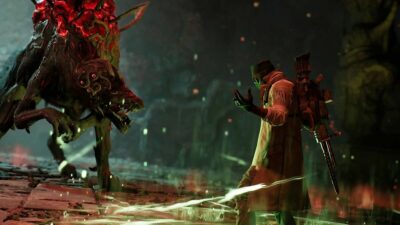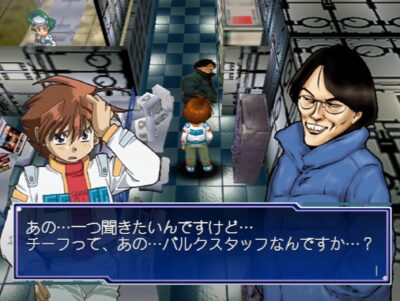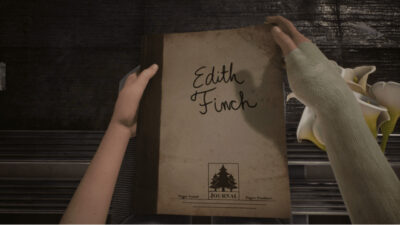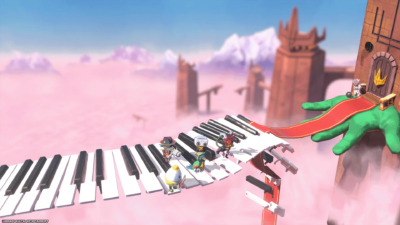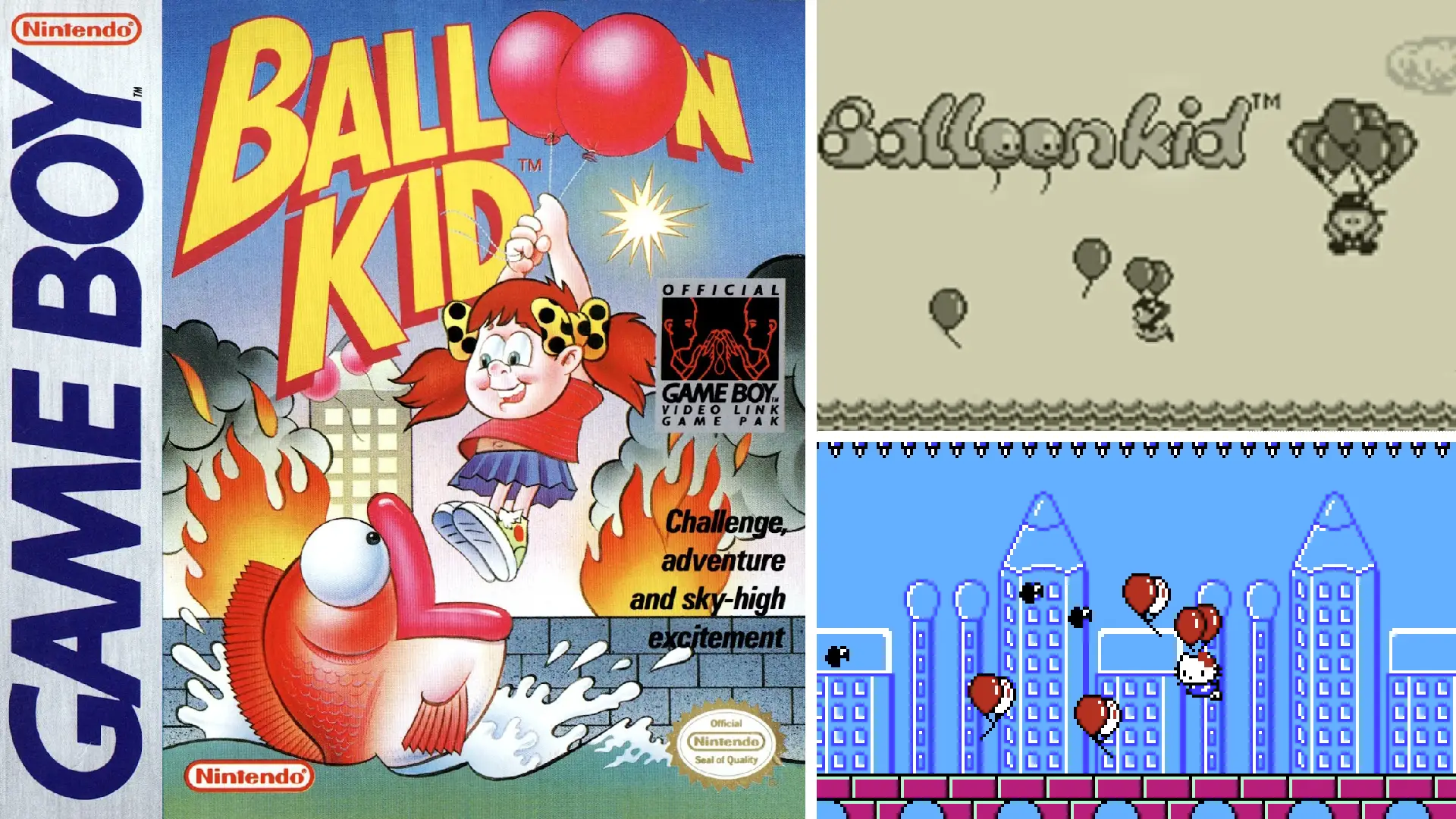
Balloon Kid has appeared in various guises on Game Boy, NES and Wii U. So why does Nintendo seem so embarrassed by the long-running series?
You know a video game has really gotten under your skin when you see a news report on the television and think, “Oh yes, that’s the plot of an old Game Boy game. I must go away and play it again.”
The report in question occurred in October 2009, when a Colorado couple, Richard and Mayumi Heene, told law enforcement officers that their six-year-old son, Falcon, had suddenly gone flying off into the sky after becoming caught up in a giant home-made helium balloon which had come loose from in its moorings in their backyard. Thankfully, it later transpired the whole thing was a hoax perpetrated by the Heenes in the deluded hope of getting their own reality TV show. Far from floating up, up and away, Falcon was later found hiding safely in the family attic.
Less lucky was a little boy named Jim (surname unknown), who in 1990 really did soar skywards after foolishly holding onto a big bunch of helium balloons – if by “really did” you mean “really did within the context of an absurdly simplistic 8-bit video game plot”.
The game was Balloon Kid, one of Nintendo’s finest but most obscure first-party Game Boy titles, whose Wikipedia page actually features a specific reader warning that it’s “Not to be confused with [the] Balloon Boy hoax” mentioned above. Indeed not. The Game Boy game was much more entertaining.
Kid Icarus
I’m not a big fan of elaborate, over-long stories in games, so the ‘story’ of Balloon Kid certainly gets my Official Nintendo Seal of Approval. One day, for reasons ridiculous, your little brother Jim holds onto a huge bunch of multi-coloured helium balloons, and floats away towards his certain doom. As his slightly older sister Alice, you must chase after him by holding onto two such helium balloons, following the balloon-trail Jim has left behind. And that’s it: now start platforming, Alice.
I say platforming, but that’s not quite the right word. Balloon Kid is more of an aerial obstacle course in which, via repeated taps of the A button, you make Alice float a bit higher, Flappy Bird-style, through a series of unusual, right-to-left auto-scrolling levels, avoiding enemies, traps and hazards, all while collecting as many of Jim’s abandoned balloons as you can.
Beginning in Pennsylvania, a demented but ultra-cute city (even major urban settlements are kawaii in Nintendo games of this era) where all the skyscrapers are shaped like giant pencils, Jim’s path through the air also takes in a forest, a cave-system, a factory and the belly of a giant whale.
Each level is bounded below by deadly sea water. Some enemies are only held afloat by balloons of their own, which you can pop by bashing into, sending them careering down to their deaths below; the trouble is, they can do exactly the same thing to you. It’s actually possible to treat much of the game as a standard, ground-based platformer if you really want, however.
Via a tap of the B button, Kamikaze Alice drops her twin balloons, and is able to run and jump through the environments – the twist being that she controls much like the proverbial Bambi on ice (particularly within the confines of the obligatory slippy-slidey ice level later on).
When you want to levitate back upwards like the saxophonist from Madness again, all you have to do is furiously tap the ‘down’ direction on the D-pad, and Alice will inflate two new balloons using a bicycle-pump. These act like a proxy life-bar; if enemies or spikes pop both of them while floating over the large expanses of water in the game, Alice will drop into the drink to be swallowed whole by a giant fish, like one of the red cheep-cheeps from Super Mario Bros 3.
It’s actually possible to complete the first two levels without using any balloons at all, but this is an endeavour best reserved for sadists. When on-foot, Alice is deliberately designed to control badly, rather than enjoyably and smoothly like Super Mario, but this facilitates an intriguing risk-reward mechanic.
If you collect enough balloons in a row, you gain an invincibility power-up or an extra life, essential for facing the horribly fiddly bosses which appear at the end of every other level, and which have to be defeated more-or-less without balloons, by jumping on their heads.
The only way to collect enough balloons in a row, though, is to drop your own two floaters on occasion and run beneath low-hanging platforms and obstacles, necessitating a tricky alternation between aerial swoops and ground-based gymnastics.
Not so big in Japan
Balloon Kid is a genuinely unusual game. Its most obvious ancestor was 1985’s Balloon Fight, which also saw players float in the air by repeatedly tapping buttons. A fixed-screen combat game akin to Joust, it was a much simpler affair than Balloon Kid, though. That loose connection aside, Balloon Kid had no real direct parallels other than its several prequels, sequels and variant versions (on which, more below).
Perhaps its originality stems from the stellar design team behind it. A product of the revered Nintendo R&D1 group, the producer was Gunpei Yokoi and the director Yoshio Sakamoto. If these names mean nothing to you, perhaps they should: they were the people behind both the creation of the Game Boy itself, and of a little something called Metroid.
Read more: Super Mario Land | Celebrating the weirdness of Mario’s Game Boy debut
Yet, unlike Metroid, which is generally considered one of Nintendo’s most widely-loved and profitable classic franchises, Balloon Kid itself firmly divides critical opinion: some reviewers say it’s great, others think it’s unplayable dreck. Perhaps this explains the title’s highly uncommon format history.
Released in the US and European markets in 1990 and 1991 respectively, the game never actually saw a Japanese release at all: almost unknown for a first-party Nintendo title. But, then again, to say Balloon Kid never saw light of day in Japan is not quite accurate: it was released domestically in the end, but under a different name, with different characters, and published under the aegis of a different company, like the video gaming equivalent of someone placed in a witness protection programme for their own safety. Why did Nintendo want to cover up their own handiwork?
The answer’s unknown. Perhaps Alice was in some kind of bother with the Japanese yakuza? Whatever the truth may be, the fact is that Alice, like an underpaid actor at a cartoon theme-park, now had to don an adorable Hello Kitty suit and star in a colourful and cheery Famicom/NES port of her original outing, now rechristened Hello Kitty World (the editor of this very website is one of the few lucky gaijin to actually own a physical copy in the west). Cosmetic details aside, the game was almost exactly the same as Alice’s Game Boy original.
The enemies were cutesified even further, a few vertical scrolling elements were removed to take account of the larger TV screen, and it was no longer Jim you were saving, but Kitty’s friend Tippy Bear. The simple but bright graphical style recalls the NES port of Taito’s The NewZealand Story more than the original Game Boy title, with the factory level now being made of Lego-type bricks, for example. But, other than that, this is Balloon Kid, dressed in big white cat-clothes.
The title screen contains another mild mystery, too. It’s credited to two separate developers. One is Sanrio, rights holders of the Hello Kitty character, but the other is not Nintendo as such, but an entity known as ‘Mario Co, Ltd’. Apparently, this was an obscure joint venture between Nintendo and a Japanese advertising company named Dentsu; presumably the idea was to gain more cash by licensing some of their more niche franchises out to be cosmetically replaced with the more popular cartoon IP of others? If so, it’s a route Nintendo seemingly never went down again.
Goodbye Kitty
In 2000, Japanese gamers finally got to see what the original, cat-less version of Balloon Kid was like, in the shape of a Game Boy Color title now named Balloon Fight GB. Apart from now having coloured graphics, the only real difference was that this updated, re-domesticated Balloon Kid gained a nice new title screen and a map between levels. This was actually a major improvement, as a save game function meant the map also acted as a level-select, so you could retry your favourite stages at will rather than having to begin over anew each time, as on the original western Game Boy release.
This particular version was overseen by another major internal Nintendo figure, Hitoshi ‘Puzzle Master’ Yamagami, who played a leading role in creating the company’s Dr Mario, Yoshi’s Cookie and Panel de Pon franchises.
Again, despite this fine pedigree, the game still didn’t receive a mainstream physical release. Instead, during these largely pre-Internet days, Nintendo of Japan offered consumers a now primitive-seeming service whereby they could buy blank rewritable cartridges for the Game Boy/Game Boy Color and Super Famicom, take them to special kiosks in game-stores, and download electronic copies of certain titles straight onto the carts for a reduced fee. Balloon Fight GB was only released in this format – although, curiously, it did come pre-loaded onto some versions of the blank cartridges (which therefore weren’t actually blank at all, then…), together with a free pin-badge for kids to pop real-life balloons with.
The curious impression gained is that Nintendo of Japan were a little embarrassed by Balloon Kid for some reason. As a notoriously divisive game, perhaps some officials within the company simply hated it? If so, then the Balloon Kid/Fight series does seem to have come back into favour a little more during the 21st century, thankfully.
There are numerous references to it in today’s Smash Bros and WarioWare games, while the brilliant 2005 DS title Yoshi’s Touch & Go (which sounds like a brand of dinosaur-shampoo, but don’t let that put you off) was originally called Yoshi’s Balloon Trip, ‘Balloon Trip’ being an endless, hi-score-based mini-game present in most versions of the Balloon Kid/Fight series.
In 2007, Japanese gamers even got their revenge on their US and European counterparts, when a Zelda-ified DS title was made available exclusively to Japanese Club Nintendo members in the shape of Tingle’s Balloon Fight DS, starring the titular rupee-hungry, green-suited little chap first seen in Majora’s Mask.
This is all quite a contrast to the way references to the apparently then-discontinued franchise had formerly had to be smuggled sneakily into more mainstream software in an almost samizdat style; some of the Game Boy original’s music appears as BGM in certain modes in the Game Boy Camera, for instance. (Modern retro-indie balloon-bursting game Tamiku also shamelessly steals its bonus-level mode, where Alice has to collect long streams of balloons emerging from Mario-style pipes, wholesale – but it’s a good game, so Nintendo kindly didn’t sue.)
Alice in Nintendo Land
And then, in 2012, something gloriously unexpected happened – a new Balloon Kid game appeared as a launch-title for Nintendo’s new Wii U console! This was Balloon Trip Breeze, and, lo, it was good. And yet, once again, it was not a full, stand-alone product, but just one of the twelve mini-games based on classic Nintendo franchises included within the wider Nintendo Land compilation collection.
Nintendo’s then-leader, the late Satoru Iwata, played a direct role in development, indicating at least some of the company’s staff still gave the forgotten franchise the love it deserved. The 2012 game uses the Wii U touch-screen to control the game’s new Balloon Kid, who is no longer Alice, but the player’s own personal Mii avatar. Gameplay is essentially the same as on the Game Boy, except for the radically different input device.
Aesthetically speaking, it recalls some of the more recent fabric and craftwork-based Yoshi’s Island games, all taking place in front of a nice quilted curtain which acts as the background, emblazoned with stars, clouds and moons, which swishes between dark and light material colours as day shifts to night and back again.
With rumours of a Switch 2 being just around the corner, will the largely overlooked Balloon Kid franchise be pumped up by Nintendo once again, just as in 2012? If, like me, you’re in the ‘love’ rather than the ‘loathe’ camp when it comes to the Game Boy original, then I hate to burst your balloon, but I think the prospect is, regrettably, rather unlikely. We’ll probably get a feeble new Hello Kitty game at some point, but it will almost certainly have nothing much to do with balloons.
For now, Balloon Kid seems fated to remain one of Nintendo’s most overlooked franchises.


